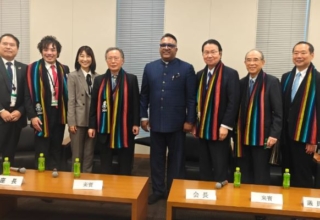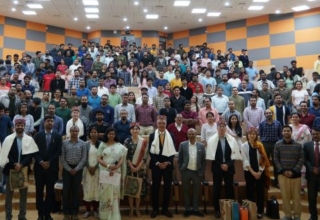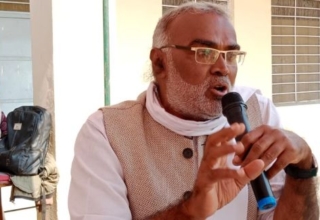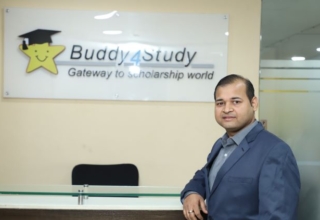
 ChildFund India, the Indian subsidiary of the US (Richmond, Virginia) based Childfund International (esb 1938) headquartered in Bengalore has launched a new campaign, “Khilta Bachpan’ in India using art as a tool of empowerment of marginalized children. Autar Nehru spoke with Neelam Makhijani ,Country Director and CEO of ChildFund India about the new imitative and Childfund India work.
ChildFund India, the Indian subsidiary of the US (Richmond, Virginia) based Childfund International (esb 1938) headquartered in Bengalore has launched a new campaign, “Khilta Bachpan’ in India using art as a tool of empowerment of marginalized children. Autar Nehru spoke with Neelam Makhijani ,Country Director and CEO of ChildFund India about the new imitative and Childfund India work.
ChildFund International celebrated its 80th anniversary last month. In India too, your organization is quite old?
Oh yes, we are about 56 years old and from the last 35 years registered as an NGO. Our footprint is not only old but widespread as well. We are present in 16 states (Andhra Pradesh, Bihar, Delhi, Chhattisgarh, Jharkhand, Karnataka, Madhya Pradesh, Uttar Pradesh, Maharashtra, Odisha, Rajasthan, West Bengal, Tamil Nadu and Puducherry) where we touch lives of 2.5 million every year through our projects and programs. In fact, ours is one of the largest children programs in India. We work with about 3000 government schools.
And what is your thrust or focus of work?
All our work is to protect children and enable them to grow holistically. We consider nutrition, education, livelihood, hygiene and protection from abuses as part of child rights as recognized by the UN. So our approach is to support provide these rights to children who are deprived, excluded and venerable. There are about 20 policies of children project in India and our endeavor is to help stakeholders in their implementation. In fact more than 80 percent of our work is in far flung backward areas with the intention of reaching the last mile child.
Can you illustrate how do you do it?
As I said children are our focus and foundation. So, we adapt to the changing dynamics of environment and requirement, bring along internationally accepted best practices and work together with various stakeholders in the government sector. Our work is in the design of interventions in alignment with project outcomes. Ours is a holistic program and begins from the age 0, that is with pregnant mothers and till the age of 24 when child becomes adult and productive. So, our range of interventions involves nutrition, education, hygiene, adolescence, career couselling, skilling, livelihoods and even higher education. We are not a charity but work on ground, that is to be remembered.
Before we move forward, would like to know about partnerships?
We have 44 partners in the country at the moment. Some work we do on our own but bulk is done in partnerships with local NGOs and groups because these become our strategic partners as there are cultural sensitivities, language barriers, access issues, etc. Depending on their performance, capacity and nature of local partners, we work together. As we don’t believe in touch and go philosophy as it causes more harm than good, so we engage our partners on long term basis after a rigorous selection process. For the kind of outreach, we can’t do it alone and that way our work is also a contribution of all our partners.
Good. How do you select projects and beneficiaries?
We follow several criteria like BPL and other government parameters. For selecting a geographical area of project, we certainly do evaluations of the families, need of interventions and how our outcomes can make an impact. As I said, we are present in interiors some of which are inaccessible practically, in tribal areas. But now we have also started our work in urban areas as migration of labor from villages brings own sets of problems for these children as they have no place to go. They need more protection.
You said, you are involved in 3000 schools. What is the nature of your involvement in these schools?
We work with only government schools. We design interventions for outcomes which will be like pedagogical training of teachers, training and capacity building of School Management Committees under RTE Act so that they assure proper implementation, we make stake holders aware of the schemes and how to participate. What is right for them and how can they do it.
Every school has to have a library under RTE. We help in arranging it, involve children in beautifying it. Likewise, it is the local need of a school and children that we work on.
You have a focus on vocational education and skilling also?
Yes, we have an integrated approach to a child. When in class 10 we start mentoring about career opportunities. After this some may need training to work, we find them those opportunities with collaborations. We skill them in entrepreneurships, business plans if some were to take self-employment etc. Livelihoods is a major thrust in our work for youth. We train drivers and in other vocations in collaboration with training partners.
And what about the higher education needs?
We sponsor those who want to pursue higher education. We facilitate them to take admissions. However, I would like to mention that it is only the government institutions to which we sponsor.
In terms of impact of such a big and noble work for so many years, do you have some success stories to show?
Many. First of all, getting children and sustaining their interest and learning for life is an ongoing process. Because of our interventions, you will find many of the marginalized children mainstreamed and leading a dignified life. Our work with tribal children of Madhya Pradesh and Jharkhand, in urban slums of Delhi, Bangalore and Mumbai, our work of last 30 years in Firozabad (Uttar Prdesh) to free children from child labor are there. We are running programs against trafficking of girls in Rajasthan, against early marriages in MP. Our every project is a success. We are training police all over the country. We work with NCPCR. Our objective is to safeguard children, ensure their rights and all this is integral to our work.
Is Khilta Bachpan is a a continuation of this thinking?
From time to time we innovate and come out with innovations and campaigns to take forward our work and philosophy. Khilta Bachpan is our latest campaign countrywide where, we would use art as a tool for empowerment of children. They can express themselves through various art forms. Theater is also part of this. We want build confidence of children, give them a platform and medium to come out with their feelings. This will give them voice and hopefully get more attention to children issues in the country.












